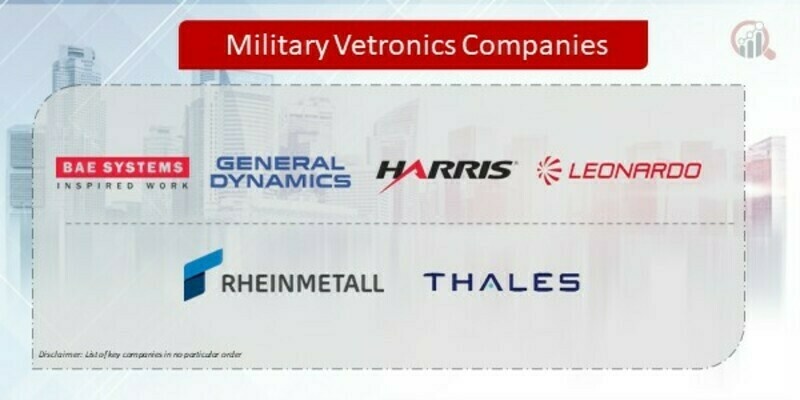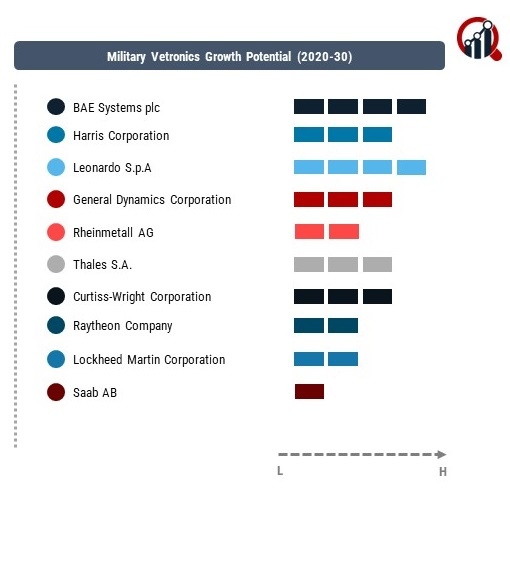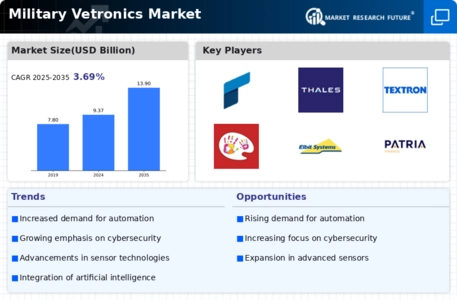Top Industry Leaders in the Military Vetronics Market

The Military Vetronics market, a crucial segment within the defense industry, is defined by fierce competition, technological innovation, and strategic initiatives among key players aiming for market dominance. Vetronics (vehicle electronics) systems encompass a wide array of technologies integrated into military vehicles, including communication systems, navigation systems, displays, sensors, and computing systems, enhancing operational efficiency and situational awareness. The market has experienced significant growth due to defense modernization programs and the increasing demand for advanced technologies to meet evolving threats on the battlefield.
The major players of the Military Vetronics Industry are mentioned below:
- BAE Systems plc (U.K.)
- Harris Corporation (U.S.)
- Leonardo S.p.A (Italy)
- General Dynamics Corporation (U.S.)
- Rheinmetall AG (Germany)
- Thales S.A. (France)
- Curtiss-Wright Corporation (U.S.)
- Raytheon Company (U.S.)
- Lockheed Martin Corporation (U.S.)
- Saab AB (Sweden)
Strategies adopted by these key players revolve around continuous innovation, strategic partnerships, and global expansions. Ongoing research and development efforts focus on integrating advanced technologies such as artificial intelligence, machine learning, and secure communication protocols into vetronics systems, aiming to enhance performance, reliability, and interoperability. Collaborations with other defense contractors, technology firms, and government entities are crucial for developing cutting-edge solutions and ensuring seamless integration into military platforms.
Factors influencing market share analysis in the Military Vetronics sector encompass technological advancements, system reliability, adaptability to diverse military vehicle platforms, cost-effectiveness, and the ability to comply with stringent military standards and specifications. Companies excelling in providing modular, scalable, and interoperable vetronics systems with superior performance and reduced lifecycle costs tend to have a competitive edge. Moreover, the provision of comprehensive aftermarket support, including maintenance, upgrades, and training services, significantly impacts market leadership.
The landscape also sees the emergence of new and agile companies striving to enter the market. Emerging players like Harris Corporation (now part of L3Harris Technologies), Leonardo S.p.A., and Saab AB specialize in niche segments or bring innovative solutions targeting specific aspects of vetronics technology. These newcomers bring fresh perspectives, technological advancements, and niche expertise, fostering innovation and intensifying competition within the Military Vetronics market.
Industry news reflects the market's dynamism, with constant announcements of significant contracts, technological advancements, and collaborations. Developments in ruggedized computing systems, advanced sensor fusion technologies, secure wireless communication solutions, and the integration of augmented reality into vetronics systems are notable trends shaping the sector. Additionally, news about government procurements, international collaborations, and advancements in military vehicle capabilities significantly influence market dynamics.
Current company investment trends in the Military Vetronics market emphasize substantial investments in research and development, technological advancements, and strategic partnerships. Key players allocate significant resources to R&D initiatives aimed at developing next-generation vetronics systems with enhanced capabilities and reduced size, weight, and power consumption. Strategic investments in acquiring specialized firms or forming alliances with complementary technology providers remain key strategies for expanding market presence and diversifying product portfolios.
Overall, the competitive scenario in the Military Vetronics market is marked by intense rivalry among established players, the emergence of innovative newcomers, ongoing technological advancements, and a persistent drive for market differentiation and expansion. The trajectory of this market is shaped by companies' abilities to stay at the forefront of technological innovation, align with evolving military requirements, comply with stringent standards, and swiftly adapt to changing geopolitical dynamics. As defense agencies worldwide prioritize advanced vetronics technologies for enhanced military vehicle capabilities, the Military Vetronics market remains poised for further evolution and competition, promising a future characterized by increasingly sophisticated and adaptable vetronics solutions.
Recent Development:
July 2022, General Dynamics Corporation secured a USD 280.1 million contract from the US Army Contracting Command to integrate active protection sensors, safeguarding the US Army's fleet of M1A2 Abrams main battle tanks from threats such as rocket-propelled grenades and anti-tank guided missiles.
February 2023, the US Army Contracting Command announced a substantial contract of USD 481.6 million awarded to the General Dynamics Mission Systems segment. This contract aims to sustain the AN/MLQ-44 Prophet-Enhanced SIGINT vetronics systems, emphasizing the importance of maintaining and supporting these critical systems for the army's signal intelligence operations.










